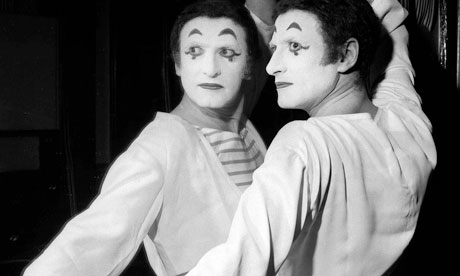Take it in turns to describe the heroes, with emphasis on their strengths and weaknesses, such as their skills, special powers, regrets and obsessions. When Player Left describes something about their hero, Player Right describes the same thing about their hero but in terms that fit into their chosen world. These descriptions are intended to flesh out the characters, they are not used to resolve any actions in the game, only to suggest what might happen during the stories to be told.
For example, Player Left says their comic book superhero has the power to shoot flames from her hands, so Player Right responds by saying their cyber-noir hero has a plasma needle gun surgically embedded in his left index finger.
Each player should take it in turn to describe a strength and a weakness, whilst also mirroring the other hero's strength & weakness, so that each hero has 2 strengths and 2 weaknesses at the end of the process.
Players also take in turn to tell the story that unfolds in the following manner:
- Player Left frames a scene with a challenge for their hero.
- Player Right mirrors the framing and narrates their hero's response to the challenge.
- Player Left mirrors the response and narrates the outcome.
- Player Right mirrors the outcome and frames a new scene and/or challenge.
- Player Left mirrors the framing and narrates their hero's response, etc.
 A short sample round of play:
A short sample round of play:Player Left: "The Scorcher is in her civilian identity, working at the TV studio, when the broadcast is hijacked by The Sinister Sub-Zero: he's threatening to bring about a new Ice Age unless his demands are met!"
Player Right: "Rezz is drinking at the bar when the sports news is interrupted by a Rogue AI threatening to freeze the entire 'net with unbreakable security protocols unless its demands are met; Rezz sighs wearily and jacks into the 'net, looking for a trail of cybercrumbs to follow."
Player Left: "The Scorcher quickly turns to Vanessa, the weather woman, and asks her about unexpected cold fronts, looking for a clue to Sub-Zero's location; Vanessa informs her that snow has been reported at Miami airport and all the planes have been grounded."
Player Right: "Rezz recognises some of the protocols the AI is using are based on those used by the National Aviation Authority for communication between planes; the AI could well be staying out of range of conventional approaches by hosting itself on an airborne mainframe! Rezz books some tickets and then jacks back into meatspace to catch his plane; the airport terminal is jammed with panicked citizens trying to flee the AI's threat..."
Mirroring can be literal or thematic: literal mirroring uses the same idea but gives it a new description appropriate to the different world, e.g. switching the flame-blasting superpower for a plasma-blasting cyber-limb. Thematic mirroring takes the description and twists it, using the same words or concepts but constructing something different out of them, e.g. switching the Ice Age for an internet freeze.
 To include more players, simply pass mirroring and narrating clockwise at every step, e.g. if Player Left describes a weakness for their hero, then Player Middle mirrors that, then describes a weakness for their hero; Player Right mirrors that and also describes a weakness, which is mirrored by Player Left, so everyone has described one weakness and mirrored one and their heroes each have two weaknesses.
To include more players, simply pass mirroring and narrating clockwise at every step, e.g. if Player Left describes a weakness for their hero, then Player Middle mirrors that, then describes a weakness for their hero; Player Right mirrors that and also describes a weakness, which is mirrored by Player Left, so everyone has described one weakness and mirrored one and their heroes each have two weaknesses.Storytelling should be staggered, so if Player Left frames the scene and the challenge, Player Middle and Player Right mirror that before Player Middle narrates their hero's response; Player Right and Player Left mirror that before Player Right narrates the outcome and so on. After each resolution, the next player clockwise takes their turn to frame the next scene, so in this example, even though Player Right narrates the resolution, it would be Player Middle who frames the scene that follows.
No comments:
Post a Comment